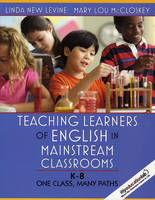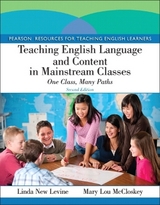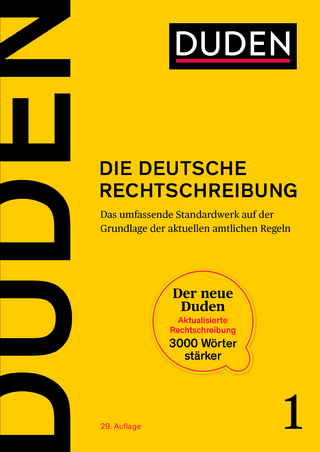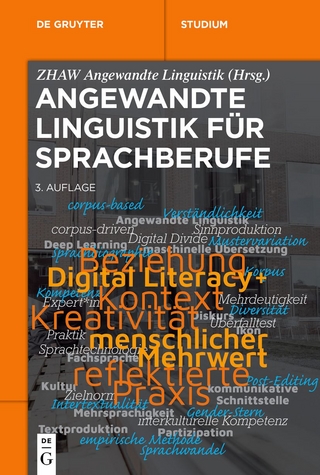
Teaching Learners of English in Mainstream Classrooms (K-8)
Pearson (Verlag)
978-0-205-41059-0 (ISBN)
- Titel erscheint in neuer Auflage
- Artikel merken
This book helps teachers teach their grade level curriculum even though they may have English language learners in their classrooms. By using the strategies provided, teachers can promote content achievement for all of their students. Specificially written for content teachers, Linda New Levine and Mary Lou McCloskey’s clear and friendly writing style emphasizes practical application of known second language learning principles. The authors offer classroom teachers practical strategies and tools to integrate content and language learning, accelerating the academic achievement of their students. Techniques for developing reading writing and speaking skills in the content areas are also emphasized.
Dr. Linda New Levine is a consultant for public school teachers of language learning children and for programs for teaching English as a Foreign Language in both primary and secondary classrooms and holds a Masters in TESOL and a Ph.D. in Applied Linguistics from New York University. . She has been a teacher of English as a Second Language and a Staff Development Facilitator for the Bedford Central school district, New York. Levine was an adjunct assistant professor of ESL Methods and Materials for school-age children at Teachers College, Columbia University and has written Elementary ESL curriculum and conducted numerous workshops with ESL, EFL and mainstream teachers in the United States, Europe, Africa and Asia. Dr. Mary Lou McCloskey, former President of TESOL, is Director of Teacher Education and Curriculum Development for Educo in Atlanta. As a consultant and author in the field of English language education, she has worked with teachers, teacher educators, and departments and ministries of education on five continents and in 35 of the 50 United States. Current projects include Teaching Tolerance through English, a project with teens and teachers in Central Europe; working as consultant to the FugeesFamily, a nonprofit group that serves school-age refugees in Atlanta, on ways to best develop literacy; and an anthology of contemporary literature for teens learning English. Author of many professional books and programs for learners, including On Our Way to English, Voices, Visions and McDougal Littell Literature. McCloskey considers her most important credential, however, her years of experience with multilingual, multicultural learners and teachers, from pre-school through postgraduate.
List of Tables, Figures, and Photos
Introduction
Chapter 1: Language Acquisition and Language Learning in the Classroom
What do we know about first language acquisition?
Language acquisition is universal
Language acquisition is natural
Language acquisition does not require instruction
What is the nature of the first language environment?
Children are immersed in language
Language is highly contextualized
Language is a tool for purposeful use
Children are physically active while learning languages
Acquisition occurs within a social environment
Children choose those aspects of language they wish to acquire
Language acquisition is emotionally embedded
Language acquisition is an integrated learning experience
How is learning a second language in the classroom different from acquiring a first language?
The acquisition and learning hypothesis
The natural order hypothesis
The input hypothesis
The affective filter hypothesis
The monitor hypothesis
What are factors affecting acquisition?
Limited language input
Classroom organization
High content and language level
Academic and social language
Negative Bias
Cognition, age, and social/cultural differences
Error correction
Culture shock
What strategies do ELLs use to acquire languages?
Overgeneralization
Transfer
Simplification
What Can ELLs Tell Us About Positive Classroom Environments and Learning Experiences?
ELLs are active acquirers
ELLs seek to find meaning
ELLs seek to use language for purposeful activity
ELLs profit from physical activity
ELLs are social beings
ELLs choose the language they want to learn
ELLs respond to an emotionally positive classroom
ELLs respond to interesting content information
Questions for Reflection
Activities for further learning
Suggested readings about first language acquisition
Suggested readings about comprehensible input
Web Sites for further learning
References
Chapter Two
Principles of Integrated Language Teaching and Learning
Activity-Based Language Teaching and Learning
Principle 1: Active Engagement.
Principle 2: Cultural Relevance
Principle 3. Collaboration
Principle 4: Learning Strategies
Communicative Teaching and Learning
Principle 5: Comprehensible Input with Scaffolding
Principle 6: Prior Knowledge
Principle 7. Content Integration
Principle 8: Differentiation
Principle 9. Clear, Appropriate Goals and Feedback
Questions for reflection
Activities for further learning
Suggested Reading
Web Resources
References
Chapter 3: Reaching Out to Home and Community
Vignette
Questions
Teachers as Cultural Mediators
How do teachers connect to the homes and families of their students?
How can the school community support the education of language learners?
How can the community outside the school support the education of ELLs?
Questions for Reflection
Activities for Further Learning
Suggested Reading
Websites for Further Learning
References
Chapter 4: Principles for Managing the Integrated Classroom
Vignette
Questions
First Things First: Feeling Ready to Learn
Greetings
Provisioning
Gathering information
Organizing the Physical Environment to Promote Language Learning
Furniture is important
Public areas
Private space
Organizing the Classroom Social Environment to Promote Language Learning
Social integration
Presentation formats
Grouping
Learning styles
Organizing Instruction to Promote Language Learning
CALLA
Sheltered instruction
Cooperative Learning
Problem-based Learning
Project Learning
Questions for Reflection
Activities for further learning
Suggested readings on sheltered instruction
Suggested readings on cooperative learning
Web Sites
References
Chapter 5: Strategies for Oral Language Development During Instruction
Vignette
Questions
Conditions for Language Learning
Academic Language Learning
What is academic language?
Culturally diverse learning patterns
Oral Language Development
Stages of Oral Language Development
Pre-production
Early Production
Speech Emergence
Intermediate Fluency
Teacher Tools for Oral Language Development
Clarity Tools
Scaffolding
Question and Response Tools
Collaborative Dialogues
Questions for Reflection
Activities for Further Learning
Suggested Reading
Web Sites for Further Learning
Chapter 6: Oral Language Development in the Content Classroom
Content Learning and Oral Language Development
Language Arts
Story Telling
Reader’s Theater
Social Studies
Math
Factors Affecting Achievement
Instructional Techniques for math class
Science
Factors Affecting Achievement
Instructional Techniques for science class
Oral Language Development Every Which Way
Songs and Chants/Poetry and Rap
Role Plays, RAFTS and Simulations
Listening In While Not Tuning Out
Sound Discrimination
Listening for Understanding
Questions for Reflection
Activities for Further Learning
Suggested Reading
Web Sites for Further Learning
References
Chapter 7: Developing Literacy with English Learners: Focus on Reading
What is literacy?
Top-down approaches
Bottom-up approaches
Integrated approaches
Unique characteristics of English learners developing literacy
What is unique about English Language Learners who are developing literacy?
What ELLs bring
2. What ELLs need
The Language/Literacy Matrix
Issues in literacy development with older English learners
What are our recommendations for these older learners?
Assessing ELL Literacy Development
Conclusion
Questions for reflection
Activities for further learning
Suggested Readings
Web resources for further learning
References
Chapter 8: Developing Literacy with English Learners: Focus on Writing
Why Teach Writing with English Learners?
How does writing develop with ELLs?
Connecting Writing to Active, Communicative Language Teaching and Learning
Challenges of teaching writing to English Learners
Developing a writing environment
Getting Started: Interactive Writing
Scaffolding Learners through the Writing Process
What is the Writing Process?
Modeling the Writing Process
Steps in Shared Writing
Assessing Writing
Determining Goals--Standards for ELL Writing.
Conclusion.
Questions for Reflection
Activities for Further Learning
Suggested Readings
Web Resources for Further Learning
References
Chapter 9: Structuring and Planning Integrated Lessons
Vignette
Questions
Lesson Characteristics which Support Learning
Teacher directed instruction
Heterogeneous grouping
Appropriate content
Attention to language
Supportive practice
Corrective feedback
A Lesson Format for Integrated Learning
Into the Lesson: Activating and Preparing for Learning
Content and Language Standards
Defining content objectives
Language objectives
Performance Indicators (3 kinds of supports)
Learning strategy Objectives (with Chamot chart)
Activation of prior and current knowledge
Through: Input for Active Understanding and Practical Purpose
Vocabulary
Language and content input
Guided practice
Check for understanding (Dipsticking)
Beyond: Providing Reasons for Further Communication
Independent practice
Summarizing
Assessment
Questions for Reflection
Activities for further learning
Suggested reading
Web sites for further learning
References
Chapter 10: Assessment Tools for the Integrated Classroom
Vignette
Questions
What is Assessment?
Test
Assessment
Evaluation
Different types of assessment
What are the fundamental principles of assessment for ELLs?
What are the critical factors affecting the assessment of ELLs
What are examples of authentic, performance-based classroom assessment?
PBA
Self-assessment
Visible criteria
How do standards affect classroom assessment?
Questions for Reflection
Activities for further learning
Suggested reading
Web site for further learning
References
Chapter 11: Putting It All Together Thematically: Developing Content-based
Thematic Units
Vignette
Questions
What is thematic instruction?
Why teach thematically?
How are thematic units structured?
· Concrete to abstract
· Low to high cognitive levels
· Simple to complex content structures
What about standards in a Thematic Unit?
Organizing Content Curriculum in a Thematic Unit
Organizing Language Curriculum in a Thematic Unit
How can Learning Strategies be incorporated in to a Thematic Unit?
A Last Word
Questions for Reflection
Activities for further learning
Suggested readings
Web sites for further learning
References
Glossary
Integrated Thematic Unit: Fairy Tales
Integrated Thematic Unit: Oceans
| Erscheint lt. Verlag | 16.10.2008 |
|---|---|
| Sprache | englisch |
| Maße | 276 x 217 mm |
| Gewicht | 862 g |
| Themenwelt | Schulbuch / Wörterbuch ► Wörterbuch / Fremdsprachen |
| Geisteswissenschaften ► Sprach- / Literaturwissenschaft ► Sprachwissenschaft | |
| Sozialwissenschaften ► Pädagogik ► Berufspädagogik | |
| ISBN-10 | 0-205-41059-6 / 0205410596 |
| ISBN-13 | 978-0-205-41059-0 / 9780205410590 |
| Zustand | Neuware |
| Informationen gemäß Produktsicherheitsverordnung (GPSR) | |
| Haben Sie eine Frage zum Produkt? |
aus dem Bereich



